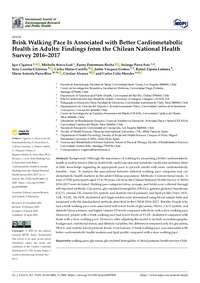Mostrar el registro sencillo de la publicación
Brisk walking pace is associated with better cardiometabolic health in adults: findings from the Chilean national health survey 2016–2017
| dc.contributor.author | Cigarroa, Igor | |
| dc.contributor.author | Bravo-Leal, Michelle | |
| dc.contributor.author | Petermann-Rocha, Fanny | |
| dc.contributor.author | Parra‑Soto, Solange | |
| dc.contributor.author | Concha-Cisternas, Yeny | |
| dc.contributor.author | Matus-Castillo, Carlos | |
| dc.contributor.author | Vásquez-Gómez, Jaime A. | |
| dc.contributor.author | Zapata-Lamana, Rafael | |
| dc.contributor.author | Parra-Rizo, Maria A. | |
| dc.contributor.author | Álvarez, Cristian | |
| dc.contributor.author | Celis-Morales, Carlos | |
| dc.date.accessioned | 2023-05-16T15:01:18Z | |
| dc.date.available | 2023-05-16T15:01:18Z | |
| dc.date.issued | 2023 | |
| dc.identifier.uri | http://repositorio.ucm.cl/handle/ucm/4793 | |
| dc.description.abstract | Background: Although the importance of walking for promoting a better cardiometabolic health is widely known (this includes both cardiovascular and metabolic/endocrine systems), there is little knowledge regarding its appropriate pace to provide adults with more cardiometabolic benefits. Aim: To analyze the associations between different walking pace categories and cardiometabolic health markers in the adult Chilean population. Methods: Cross-sectional study. A total of 5520 participants aged 15 to 90 years old from the Chilean National Health Survey (CNHS) 2016–2017 were included. Walking pace categories (slow, average, and brisk) were collected through self-reported methods. Glycaemia, glycosylated hemoglobin (HbA1c), gamma glutamyl transferase (GGT), vitamin D2, vitamin D3, systolic and diastolic blood pressure, and lipid profile (Total, HDL, LDL, VLDL, No HDL cholesterol and triglycerides) were determined using blood sample tests and measured with the standardized methods described in the CNHS 2016–2017. Results: People who had a brisk walking pace were associated with lower levels of glycaemia, HbA1c, GGT, systolic and diastolic blood pressure, and higher vitamin D3 levels compared with those with a slow walking pace. Moreover, people with a brisk walking pace had lower levels of VLDL cholesterol compared with those with a slow walking pace. However, after adjusting the model to include sociodemographic background, nutritional status, and lifestyle variables, the differences remained only for glycaemia, HbA1c and systolic blood pressure levels. Conclusions: A brisk walking pace was associated with better cardiometabolic health markers and lipid profile compared with a slow walking pace. | es_CL |
| dc.language.iso | en | es_CL |
| dc.rights | Atribución-NoComercial-SinDerivadas 3.0 Chile | * |
| dc.rights.uri | http://creativecommons.org/licenses/by-nc-nd/3.0/cl/ | * |
| dc.source | International Journal of Environmental Research and Public Health, 20(8), 5490 | es_CL |
| dc.subject | Walking pace | es_CL |
| dc.subject | Glycaemia | es_CL |
| dc.subject | Glycosylated hemoglobin A | es_CL |
| dc.subject | Blood pressure | es_CL |
| dc.subject | Health surveys | es_CL |
| dc.subject | Chile | es_CL |
| dc.title | Brisk walking pace is associated with better cardiometabolic health in adults: findings from the Chilean national health survey 2016–2017 | es_CL |
| dc.type | Article | es_CL |
| dc.ucm.indexacion | Scopus | es_CL |
| dc.ucm.indexacion | Isi | es_CL |
| dc.ucm.uri | mdpi.com/1660-4601/20/8/5490 | es_CL |
| dc.ucm.doi | doi.org/10.3390/ijerph20085490 | es_CL |



